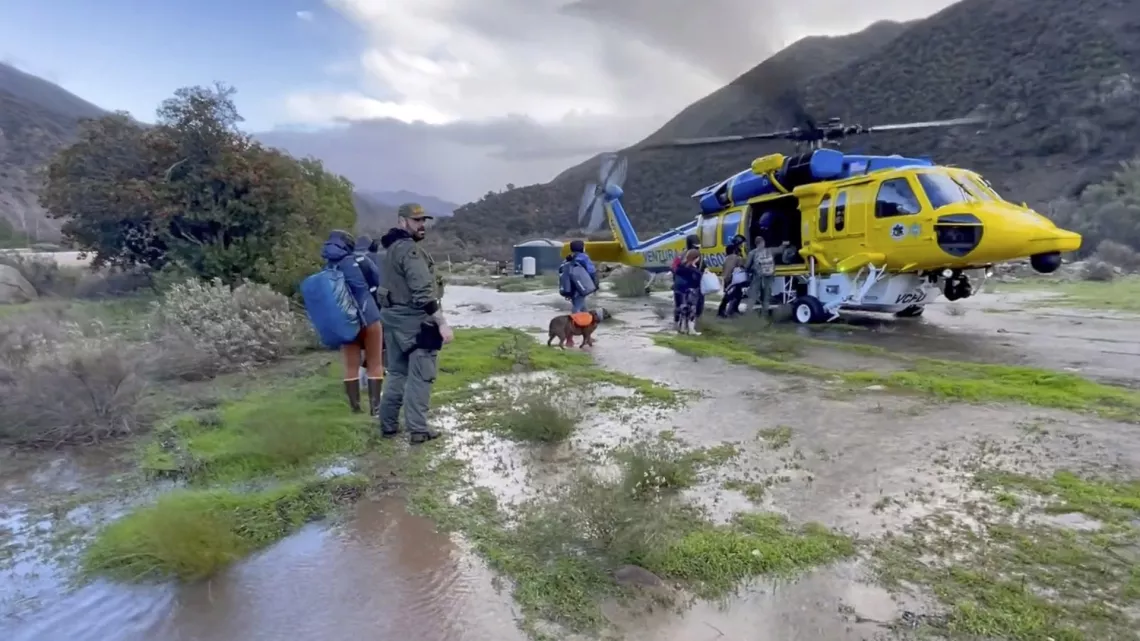By John Hankins

Well, that was some chunk of weather in January, wreaking havoc throughout our Santa Barbara-Ventura region but helpfully filling our reservoirs.
In the first three weeks of January, nine atmospheric rivers dumped an estimated 32 trillion gallons of rain and snow on California, but not enough to end our severe drought condition.
One person died locally, Christina Lorenzen, 35, who was in a makeshift home along the Santa Clara River. About 80 homes were damaged, and two destroyed (Matilija Canyon and one along Santa Ana Road). About 20 people were rescued via helicopters from the Ventura River.
Ventura County Sheriff’s Tactical Response Team airlifted at least 75 residents from Matilija Canyon after the rains isolated it from the rest of the world. Some residents stayed put while 17 inches of rainfall over the course of one week left “towering piles of rock and mud” as high as 40 feet in some locations, blocking the single road into and out of the canyon.
Montecito was under evacuation orders and on January’s Friday the 13th CA Gov. Gavin Newsom visited Santa Barbara County. He was surveying storm damage with local leaders at the Randall Road Debris Basin in Montecito where members of the National Guard (from Chico!) were working around the clock to clear out debris.
Newsom described how amazing it is that the Montecito community has shown resilience and came together in the Jan. 9 debris flow aftermath that killed 23 people in 2018.
Neighborhoods flooded and residents were displaced in SB’s North County along Tepusquet Canyon and Bonita School Roads, Orcutt and Guadalupe.
Beaches were bummed out in both counties. Having enjoyed a King Tide earlier in January, the famed Surfer’s Point in Ventura was inundated with sewage that poured down the Ventura River from the Ojai region, as well as tons of debris.
So, too, in Montecito and Santa Barbara. On Jan. 17, about 5,760 gallons of sewage from a compromised pipeline at San Ysidro Creek, on East Valley Lane in Montecito, caused closure of Miramar Beach and Fernald Point. During the Jan. 9 storm, 5,000 gallons of sewage spilled into a storm drain discharging to Mission Creek, closing West Beach in Santa Barbara for several days.
Numerous roads were closed in both counties, notably Hwy 101 for a few days between our two counties, along with train tracks damaged, halting train services.
And to make communications worse, three popular radio stations on the South Coast were off air for over a week due to the loss of power at the Gibraltar transmission site. Two power poles were knocked down along Gibraltar Road cutting power to the site with backup generators failing to work.
Citing the “atmospheric river” event that delivered record rainfall amounts January 8-10 ranging from 17 inches at San Marcos Pass on the Santa Barbara Ranger District to 18 inches in the Ojai backcountry, Los Padres Forest ordered a 60-day closure to four districts on Jan. 13. Mt. Pinos District was not included in the order and the Santa Monica mountains remain largely open.
The forest will be open “as soon as it’s safe to do so,” said Supervisor Chris Stubbs. Violating the order might bring fines of up to $5,000 or six month incarceration. For those who incurred damage, call 800 621-3362 or visit DisasterAssistance.gov.
* * *
But is climate change the culprit?
So far, this winter’s storms have been largely in line with past ones except in their unrelenting pace, said Michael Anderson, California’s state climatologist. “This is where we’re getting hit this year: We’re seeing a lot of big storms fairly quickly.”
The storms in January were called “atmospheric rivers” which form when winds over the Pacific draw moisture from the band of warm, moist air over the tropics and channel it toward the West Coast. When it hits the Sierra Nevada and other mountains, it is forced upward, cooling it and turning its water into immense quantities of rain and snow.
While such intense storms have happened over years, heating the atmosphere via burning fossil fuels would exacerbate the effects. Scientists are studying whether global warming might be shifting the way winds carry moisture around the atmosphere, potentially influencing the number of storms that sweep through California each year and how long they last. They have not yet come to firm conclusions on these questions.
But one study last year by the National Center for Atmospheric Research concluded that the chances of having such damaging storms was 1 in 50 in the last hundred years, but climate change today has at least doubled those odds.
For more, visit the Sierra Club’s Grassroots Network team page on climate change.